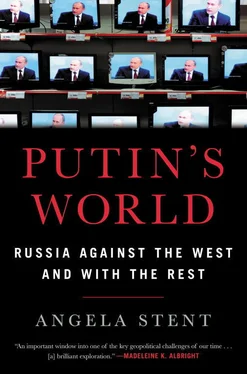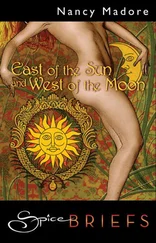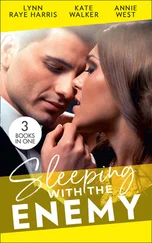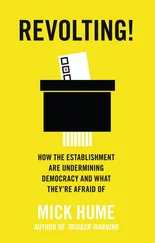The next chapter covers the Middle East, highlighting the other foreign policy success story of the Putin era. Russia has returned to the Middle East as the only major power that can talk to the protagonists and antagonists in all of the major regional conflicts—Iran, the Sunni states, Israel, the Palestinians, and the Kurds.
The final two chapters come to the great conundrum—the increasingly adversarial US-Russia relationship, which resembles a new Cold War that some fear could even deteriorate into a hot war. Why has it been so difficult to create a durable framework for productive ties between the two countries? Unrealistic expectations about the relationship on both sides and fundamentally different views of what drives international politics have created a downward spiral. Moreover, in the aftermath of the 2016 election, Russia has become a toxic domestic issue as never before.
What is the future for Putin’s world? The book concludes by discussing Putin’s seven pillars for restoring Russia as a great power, and the domestic constraints that will shape Russia going forward. It calls for a combination of realism, push-back, and strategic patience in the West’s response to Putin’s world.
 1
1 
THE WEIGHT OF THE PAST
Time and time again attempts were made to deprive Russians of their historical memory, even of their language and to subject them to forced assimilation…. In short, we have every reason to assume that the infamous policy of containment, led in the eighteenth, nineteenth, and twentieth centuries, continues today. [Western countries] are constantly trying to sweep us into a corner because we have an independent position, because we maintain it and because we call things like they are and do not engage in hypocrisy.
—Vladimir Putin, announcing the annexation of Crimea, March 14, 2014 1
We must start working to become self-sufficient, all the more so since Russia is one of the few countries to which God, nature, ancestors, and history have guaranteed this self-sufficiency.
—Sergei Lavrov, speaking to a youth forum, August 24, 2015 2
On February 7, 2014, a beaming, self-confident Vladimir Putin strode out onto the stage and welcomed thousands of athletes and spectators to the first Winter Olympics in Sochi. It had been a tough and controversial competition for Russia to win the games for this picturesque Black Sea resort with a subtropical climate. Rumors abounded about everything from how Russia had won the Olympics to their price tag to shoddy workmanship on the facilities and new hotels. Following a terrorist bombing at a regional railway station, and threats of more attacks, security precautions were extraordinarily tight. No Western leaders were in attendance at the games because of Russia’s domestic clampdown, but the Chinese and Japanese leaders were there. The head of the United States delegation was a former cabinet secretary, now chancellor of the University of California. Nevertheless, on this first night the athletes were excited, and television viewers around the world eagerly anticipated the opening ceremony and Russia’s chance to present its unique history. This was the Kremlin’s opportunity to showcase its view of the world.
Expertly produced, the opening ceremony was a riveting ride through Russian history, notable both for what it included and for what it omitted. The narrator was a young girl, Liuba, who flew through time and space and presented the highlights of Russia’s past through the alphabet, each letter representing a major figure in Russia’s one-thousand-year history. The heroes she met included Tsar Peter the Great, who built the capital Saint Petersburg on a swampland; Catherine the Great, the German princess during whose rule Russia greatly expanded its borders; the composer Peter Tchaikovsky; the poet Alexander Pushkin; the exiled artist Marc Chagall, who painted fiddlers on the roofs of his native Vitebsk; the film director Sergei Eisenstein; the literary titans Leo Tolstoy and Fyodor Dostoyevsky; and the cosmonaut Yuri Gagarin. Russia’s vast spaces, its beautiful snowy landscapes, and its hardworking peasants and scenic villages featured prominently, as did music by Russia’s great composers. The Bolshevik Revolution and the Soviet Young Pioneers with their distinctive red scarves and motto “Always prepared” made appearances. There was Soviet-era nostalgia in the form of the great exploits in space and curious 1960s-era Hipsters. But what was missing was also notable. The Gorbachev era with its perestroika and the eventual Soviet collapse were entirely absent, as were the difficult 1990s under Boris Yeltsin. The opening ceremonies for the Sochi Olympics were extravagant, a paean to Russian history, to its triumphs and tragedies. This was Russia at its grandiose best, overcoming difficulties and always returning to its great natural endowments and hardy citizens, who endure and triumph over all adversity with no help from the outside world. This was the Russia Vladimir Putin presented both to his own people and to the outside world.
But even while the games were taking place, and far away from the enthusiasm and sportsmanship, the Kremlin was making plans that would soon drastically undermine the Olympics goodwill. Three days after the main games ended, “little green men”—unidentified military personnel from Russia—began to appear in Sevastopol and other cities on the Crimean Peninsula. Only 315 miles northwest of Sochi and also on the Black Sea, Crimea had belonged to Russia since Catherine the Great wrested it from the Ottoman Empire and the indigenous Crimean Tatars in 1783.
Crimea had occupied a unique place in the Russian imagination for more than two hundred years. It was a popular vacation destination for Russians, immortalized in Anton Chekhov’s short stories. For many outside the Soviet Union, its most famous city was Yalta, where Joseph Stalin met Franklin Roosevelt and Winston Churchill just before the end of World War Two in the Livadia Palace to negotiate over the postwar world. Sevastopol was a major warm-water port for the Soviet navy. Crimea had been part of the Russian Empire and, after the establishment of the USSR, part of the Russian republic within the Soviet Union. In 1954, to commemorate the 300th anniversary of Ukraine’s union with Russia, Soviet leader Nikita Khrushchev decided to “give” Crimea to the Ukrainian Soviet Socialist Republic. As Putin said in October 2014, “In 1954, Khrushchev, who liked to bang his shoe at the UN, decided for some reason to transfer Crimea to Ukraine.” 3At that point the gesture had limited meaning, since both republics were part of the USSR. But this administrative maneuver had major repercussions once the Soviet Union fell apart at the end of 1991. By an accident of history, Crimea became part of an independent Ukraine. But Russians and their leaders had resented what they considered a historical travesty. Moreover, the Black Sea Fleet was still housed there, but only on a leasing arrangement. By 2014, the Kremlin was determined to right this wrong. A few weeks after the little green men began to appear, Russia organized a referendum in which the majority of Crimea’s citizens voted to leave Ukraine and join Russia. 4A little more than a month after the opening festivities in Sochi, Russia had officially annexed Crimea, violating agreements signed in 1994 and 1997 to respect the sovereignty and territorial integrity of the new Ukraine. Russia’s relations with the West began their descent into their worst phase since the communist red hammer-and-sickle flag was lowered from over the Kremlin on Christmas Day in 1991 and replaced by the red, white, and blue flag of the new Russian Federation.
Читать дальше

 1
1 










